OLDSMOBILE SILHOUETTE 2003 Owners Manual
Manufacturer: OLDSMOBILE, Model Year: 2003, Model line: SILHOUETTE, Model: OLDSMOBILE SILHOUETTE 2003Pages: 466, PDF Size: 21.55 MB
Page 301 of 466

Weight of the Trailer
How heavy can a trailer safely be?
It should never weigh more than 1,400 Ibs. (630 kg) with
up to six occupants or more than
2,000 Ibs. (900 kg)
with up to two occupants.
If you have the optional trailer
towing package, your vehicle can tow up to 2,900 Ibs.
(1 300 kg) with up to six occupants or up to 3,500 Ibs.
(1 575 kg) with up to two occupants. But even that
can be too heavy.
It depends on how you plan to use your rig. For example,
speed, altitude, road grades, outside temperature and
how much your vehicle is used to pull a trailer are all
important. And, it can also depend on any special
equipment that you have on your vehicle.
You can ask your dealer for our trailering information or
advice, or you can write us at:
Oldsmobile Customer Assistance
P.O. Box 33171
Detroit,
MI 48232-51 71
In Canada, write to:
General Motors of Canada Limited
Customer Communication Centre, 163-005
1908 Colonel Sam Drive
Oshawa, Ontario L1H 8P7
Weight of the Trailer Tongue
The tongue load (A) of any trailer is an important weight
to measure because
it affects the total or gross weight
of your vehicle. The Gross Vehicle Weight (GVW)
includes the curb weight of the vehicle, any cargo you
may carry in it, and the people who will be riding in
the vehicle. And
if you will tow a trailer, you must add
the tongue load to the GVW because your vehicle will be
carrying that weight,
too. See Loading Your Vehicle
on page 4-34 for more information about your vehicle’s
maximum load capacity.
A B
4-38
Page 302 of 466
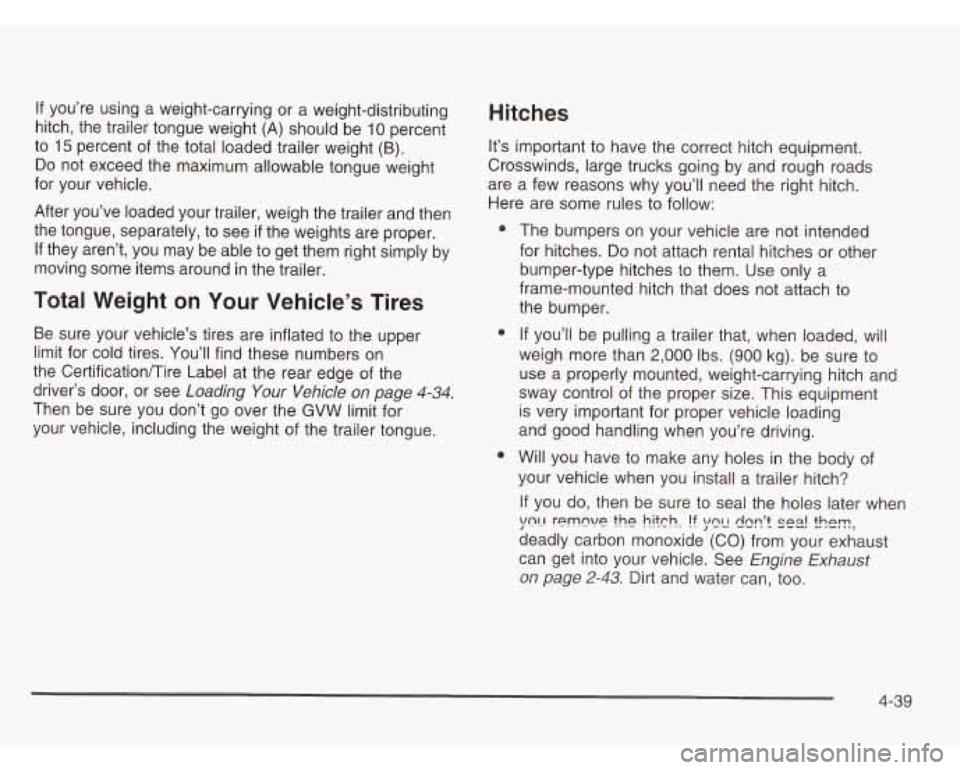
If you’re using a weight-carrying or a weight-distributing
hitch, the trailer tongue weight
(A) should be 10 percent
to
15 percent of the total loaded trailer weight (B).
Do not exceed the maximum allowable tongue weight
for your vehicle.
After you’ve loaded your trailer, weigh the trailer and then
the tongue, separately, to see
if the weights are proper.
If they aren’t, you may be able to get them right simply by
moving some items around in the trailer.
Total Weight on Your Vehicle’s Tires
Be sure your vehicle’s tires are inflated to the upper
limit for cold tires. You’ll find these numbers on
the Certification/Tire Label at the rear edge of the
driver’s door, or see
Loading Your Vehicle on page 4-34
Then be sure you don’t go over the GVW limit for
your vehicle, including the weight of the trailer tongue.
Hitches
It’s important to have the correct hitch equipment.
Crosswinds, large trucks going by and rough roads
are a few reasons why you’ll need the right hitch.
Here are some rules to follow:
The bumpers
on your vehicle are not intended
for hitches.
Do not attach rental hitches or other
bumper-type hitches to them. Use only a
frame-mounted hitch that does not attach to
the bumper.
If you’ll be pulling a trailer that, when loaded, will
weigh more than
2,000 Ibs. (900 kg). be sure to
use a properly mounted, weight-carrying hitch and
sway control of the proper size. This equipment
is very important for proper vehicle loading
and good handling when you’re driving.
Will you have to make any holes in the body of
your vehicle when you install a trailer hitch?
If you do, then be sure to seal the holes later when
deadly carbon monoxide (CO) from your exhaust
can get into your vehicle. See
Engine Exhaust
on page
2-43. Dirt and water can, too.
yx! re!-!-!nve !!-!e hitch. !f \’E! den'? sn2! !!?%??,
4-39
Page 303 of 466
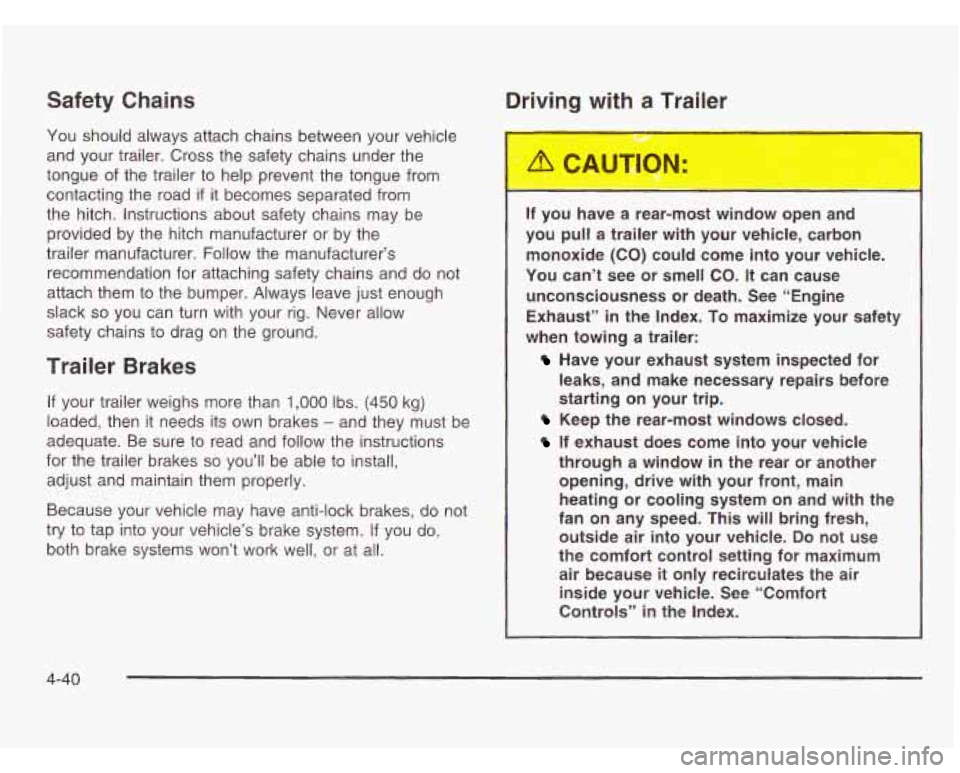
Safety Chains
You should always attach chains between your vehicle
and your trailer. Cross the safety chains under the
tongue
of the trailer to help prevent the tongue from
contacting the road
if it becomes separated from
the hitch. Instructions about safety chains may be
provided by the hitch manufacturer or by the
trailer manufacturer. Follow the manufacturer’s
recommendation for attaching safety chains and do not
attach them to the bumper. Always leave just enough
slack
so you can turn with your rig. Never allow
safety chains to drag on the ground.
Trailer Brakes
If your trailer weighs more than 1,000 Ibs. (450 kg)
loaded, then it needs its own brakes
- and they must be
adequate. Be sure to read and follow the instructions
for the trailer brakes
so you’ll be able to install,
adjust and maintain them properly.
Because your vehicle may have anti-lock brakes, do not
try to tap into your vehicle’s brake system.
If you do,
both brake systems won’t work well, or at all.
Driving with a Trailer
If you have a rear-most window open and
you pull a trailer with your vehicle, carbon monoxide (CO) could come into your vehicle.
You can’t see or smell
CO. It can cause
unconsciousness or death. See “Engine
Exhaust” in the Index.
To maximize your safety
when towing a trailer:
Have your exhaust system inspected for
leaks, and make necessary repairs before
starting on your trip.
Keep the rear-most windows closed.
If exhaust does come into your vehicle
through a window
in the rear or another
opening, drive with your front, main
heating or cooling system on and with the
fan on any speed. This will bring fresh,
outside air into your vehicle.
Do not use
the comfort control setting for maximum air because
it only recirculates the air
inside your vehicle. See ‘“Comfort
Controls” in
the Index.
4-40
Page 304 of 466
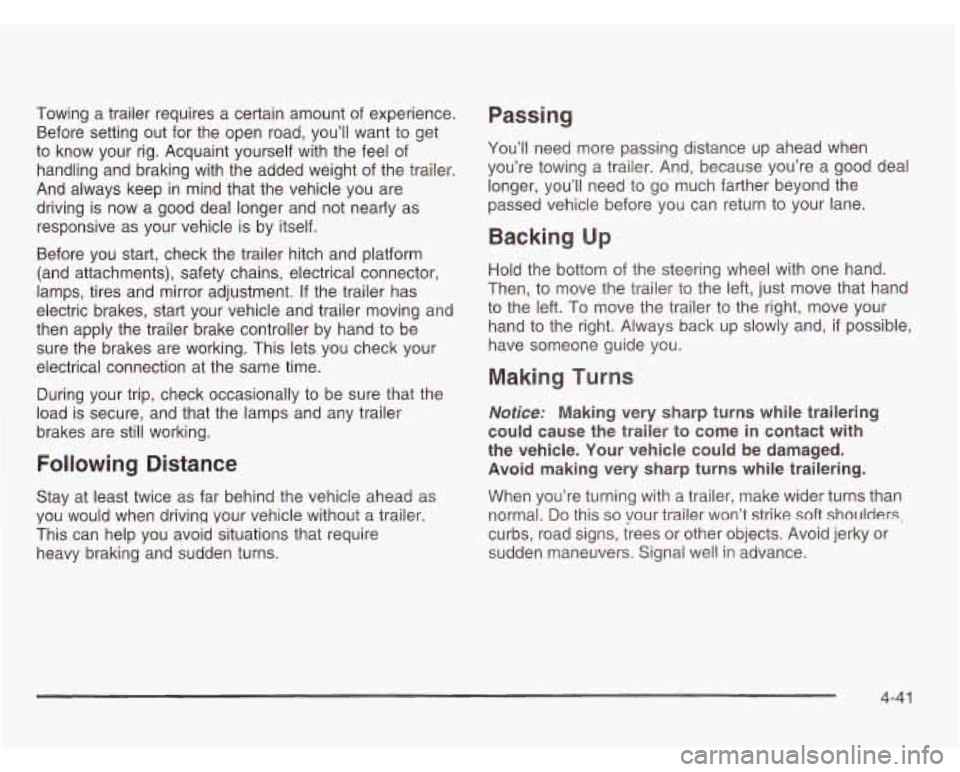
rowing a trailer requires a certain amount of experience.
Before setting out for the open road, you’ll want to get
to know your rig. Acquaint yourself with the feel of
handling and braking with the added weight of the trailer.
And always keep in mind that the vehicle you are
driving is now a good deal longer and not nearly as
responsive as your vehicle is by itself.
Before you start, check the trailer hitch and platform
(and attachments), safety chains, electrical connector,
lamps, tires and mirror adjustment. If the trailer has
electric brakes, start your vehicle and trailer moving and
then apply the trailer brake controller by hand to be
sure the brakes are working. This lets you check your
electrical connection at the same time.
During your trip, check occasionally to be sure that the
load is secure, and that the lamps and any trailer
brakes are still working.
Following Distance
Stay at least twice as far behind the vehicle ahead as
you would when driving your vehicle without a trailer.
This can help you avoid situations that require
heavy braking and sudden turns.
Passing
You’ll need more passing distance up ahead when
you’re towing a trailer. And, because you’re a good deal
longer, you’ll need to go much farther beyond the
passed vehicle before you can return to your lane.
Backing Up
Hold the bottom of the steering wheel with one hand.
Then, to move the trailer to the left, just move that hand
to the left. To move the trailer to the right, move your
hand to the right. Always back up slowly and,
if possible,
have someone guide you.
Making Turns
Notice: Making very sharp turns while trailering
could cause the trailer
to come in contact with
the vehicle. Your vehicle could be damaged.
Avoid making very sharp turns while trailering.
When you’re turning with a trailer, make wider turns than
normal.
Do this so your trailer won’t strike soft shoulders;
curbs, road signs, trees or other objects. Avoid jerky or
sudden maneuvers. Signal well
in advance.
4-41
Page 305 of 466
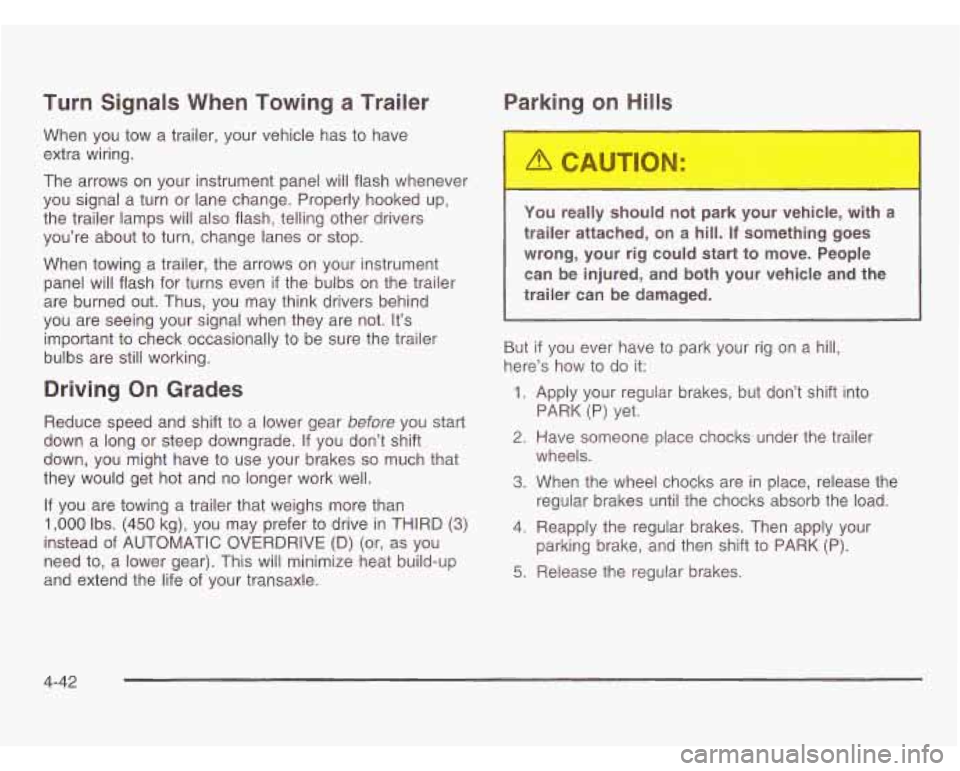
Turn Signals When Towing a Trailer
When you tow a trailer, your vehicle has to have
extra wiring.
The arrows on your instrument panel will flash whenever
you signal a turn or lane change. Properly hooked up,
the trailer lamps will also flash, telling other drivers
you’re about
to turn, change lanes or stop.
When towing a trailer, the arrows on your instrument
panel will flash for turns even
if the bulbs on the trailer
are burned out. Thus, you may think drivers behind
you are seeing your signal when they are not.
It’s
important to check occasionally to be sure the trailer
bulbs are still working.
Driving On Grades
Reduce speed and shift to a lower gear before you start
down a long or steep downgrade. If you don’t shift
down, you might have
to use your brakes so much that
they would get hot and no longer work well.
If you are towing a trailer that weighs more than
1,000 Ibs. (450 kg), you may prefer to drive in THIRD (3)
instead of AUTOMATIC OVERDRIVE (D) (or, as you
need
to, a lower gear). This will minimize heat build-up
and extend the life of your transaxle.
Parking on Hills
I
You really should not park your vehicle, u....~ a
trailer attached, on a hill. If something goes
wrong, your rig could start to move. People can be injured, and both your vehicle and the
trailer can be damaged.
But
if you ever have to park your rig on a hill,
here’s how to do it:
1. Apply your regular brakes, but don’t shift into
2, Have someone place chocks under the trailer
3. When the wheel chocks are in place, release the
PARK
(P) yet.
wheels. regular brakes until the chocks absorb the load.
4. Reapply the regular brakes. Then apply your
parking brake, and then shift
to PARK (P).
5. Release the regular brakes.
4-42
Page 306 of 466
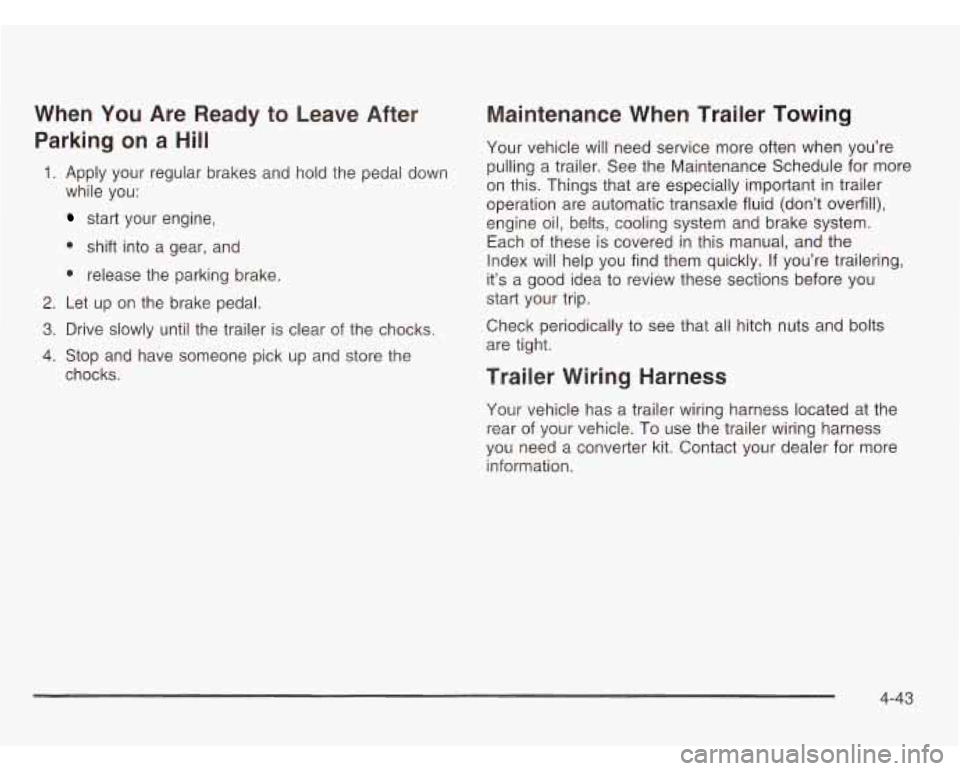
When You Are Ready to Leave After
Parking on a Hill
1. Apply your regular brakes and hold the pedal down
while you:
start your engine,
* shift into a gear, and
* release the parking brake.
2. Let up on the brake pedal.
3. Drive slowly until the trailer is clear of the chocks.
4. Stop and have someone pick up and store the
chocks.
Maintenance When Trailer Towing
Your vehicle will need service more often when you’re
pulling a trailer. See the Maintenance Schedule for more
on this. Things that are especially important in trailer
operation are automatic transaxle fluid (don’t overfill),
engine
oil, belts, cooling system and brake system.
Each of these is covered in this manual, and the
Index will help you find them quickly.
If you’re trailering,
it’s a good idea to review these sections before you
start your trip.
Check periodically
to see that all hitch nuts and bolts
are tight.
Trailer Wiring Harness
Your vehicle has a trailer wiring harness located at the
rear of your vehicle.
To use the trailer wiring harness
you need a converter kit. Contact your dealer for more
information.
4-43
Page 307 of 466
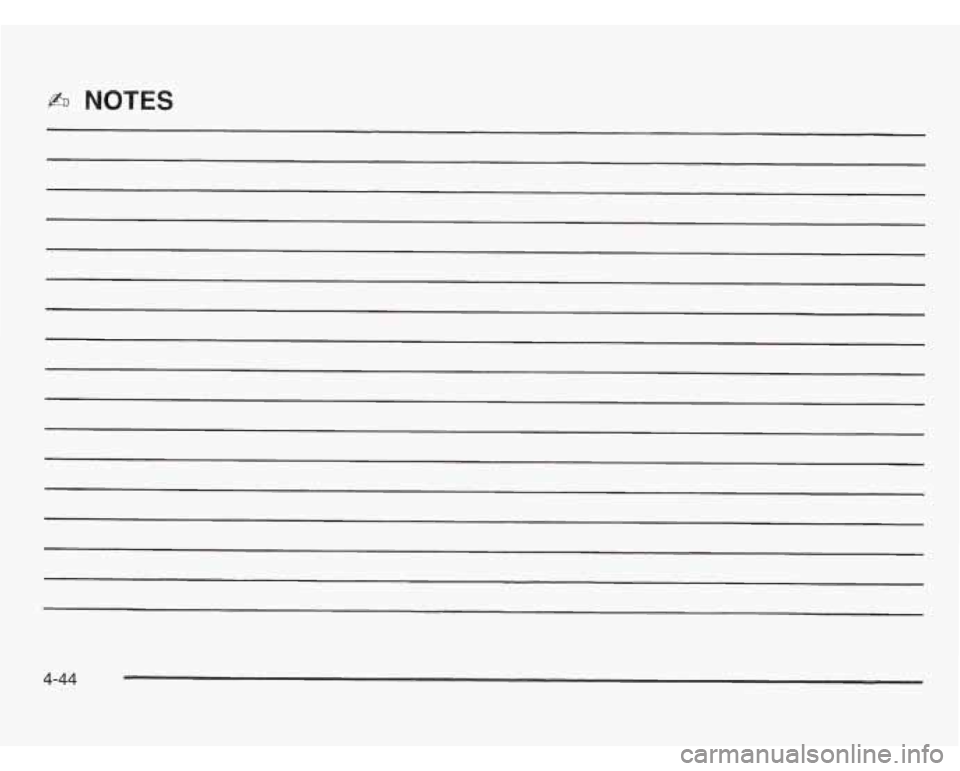
4 P P
Page 308 of 466
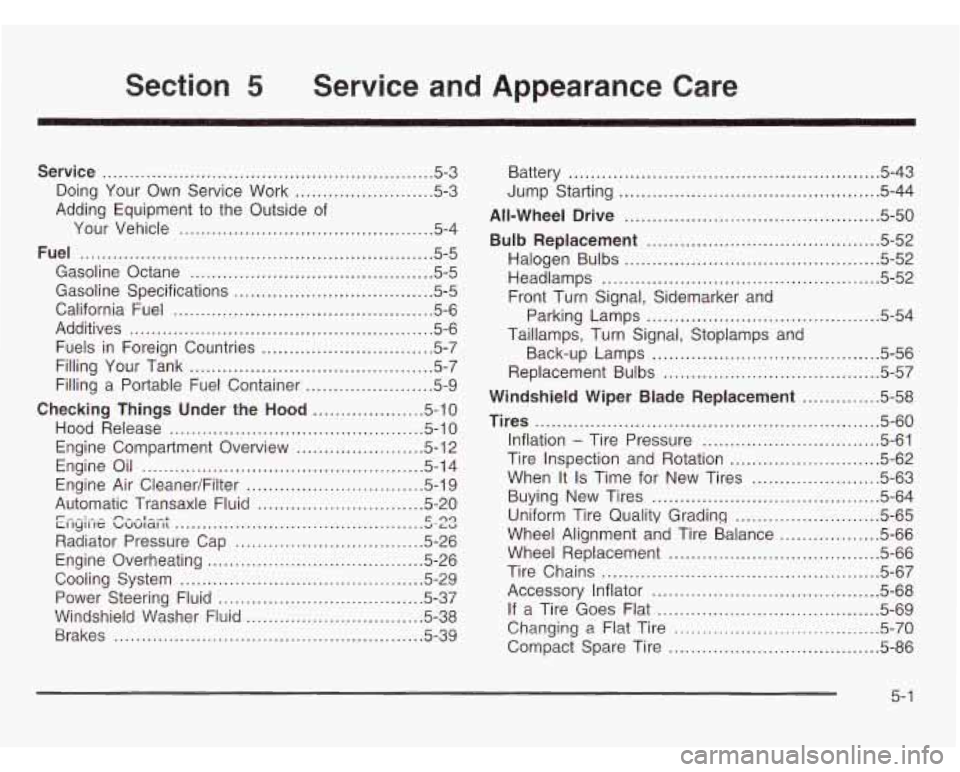
Section 5 Service and Appearance Care
Service ............................................................ 5.3
Doing Your Own Service Work
......................... 5.3
Adding Equipment to the Outside
of
Your Vehicle .............................................. 5-4
Fuel
.............................................................. -5-5
Gasoline Octane
............................................ 5-5
Gasoline Specifications
................................... 5-5
California Fuel
............................................... 5-6
Additives
....................... .... ......... 5-6
Fuels in Foreign Countries
........... ..... 5-7
Filling Your Tank
............................ ..... 5-7
Filling a Portable Fuel Container
.................... 5-9
Checking Things Under the
Hood .................. -5-1 0
Hood Release .............................................. 5-10
Engine Compartment Overview ....................... 5-12
Engine Oil
................................................... 5-14
Engine Air CleanedFilter
................................ 5-19
Automatic Transaxle Fluid
.............................. 5-20
Radiator Pressure Cap
............................... 5-26
Engine Overheating
.................................... 5-26
Cooling System
............................. , ....... 5-29
Power Steering Fluid .................. , ....... 5-37
Windshield Washer Fluid
................. , ....... 5-38
Brakes
.......................... .... ........ 5-39
r.--.:.-- ---I-.- b CI lyll IC uuvlal I1 4-LU c r)r) .............................................
Battery ........................................................ 5.43
Jump Starting
............................................... 5-44
All-Wheel Drive
.............................................. 5-50
Bulb Replacement .......................................... 5-52
Halogen Bulbs
.............................. ......... 5-52
Front Turn Signal, Sidemarker and
Taillamps, Turn Signal, Stoplamps and
Headlamps
...................................... ..... 5-52
Parking Lamps
.............................. ..... 5-54
Replacement Bulbs
....................................... 5-57
Back-up Lamps
......................................... 5-56
Windshield Wiper Blade Replacement
.............. 5-58
Tires
.............................................................. 5-60
Inflation
- Tire Pressure ................................ 5-61
Tire Inspection and Rotation
........................... 5-62
When It
Is Time for New Tires ....................... 5-63
Buying New Tires
......................................... 5-64
Uniform Tire Quality Grading
.......................... 5-65
Wheel Alignment and Tire Balance
.................. 5-66
Wheel Replacement
...................................... 5-66
Tire Chains
.................................................. 5-67
Accessory Inflator
......................................... 5-68
If a Tire Goes Flat ........................................ 5-69
Changing a Flat Tire ..................................... 5-70
Compact Spare Tire ...................................... 5-86
5- 1
Page 309 of 466
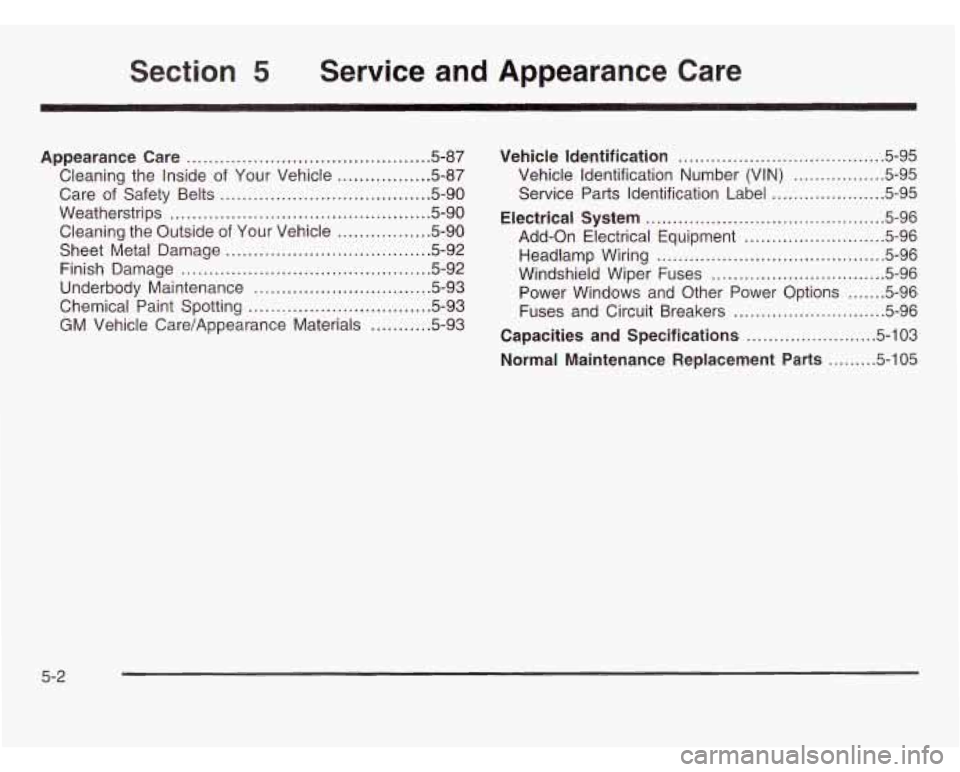
Section 5 Service and Appearance Care
Appearance Care ............................................ 5.87
Care of Safety Belts ...................................... 5-90
Weatherstrips
............................................... 5-90
Sheet Metal Damage
..................................... 5.92
Finish Damage
............................................. 5.92
Underbody Maintenance
................................ 5.93
Chemical Paint Spotting
................................. 5.93
GM Vehicle Care/Appearance Materials
........... 5.93
Cleaning
the Inside
of Your Vehicle ................. 5-87
Cleaning the Outside of Your Vehicle ................. 5-90 Vehicle
Identification
........................ ...... 5.95
Vehicle Identification Number (VIN)
... ...... 5.95
Service Parts Identification Label
... ...... 5.95
Electrical System
.......................... .......... 5.96
Add-on Electrical Equipment
...................... 5.96
Headlamp Wiring
.......................................... 5.96
Windshield Wiper Fuses
................................ 5.96
Power Windows and Other Power Options
....... 5.96
Fuses and Circuit Breakers
............................ 5.96
Capacities and Specifications
........................ 5.103
Normal Maintenance Replacement Parts
......... 5.105
5-2
Page 310 of 466
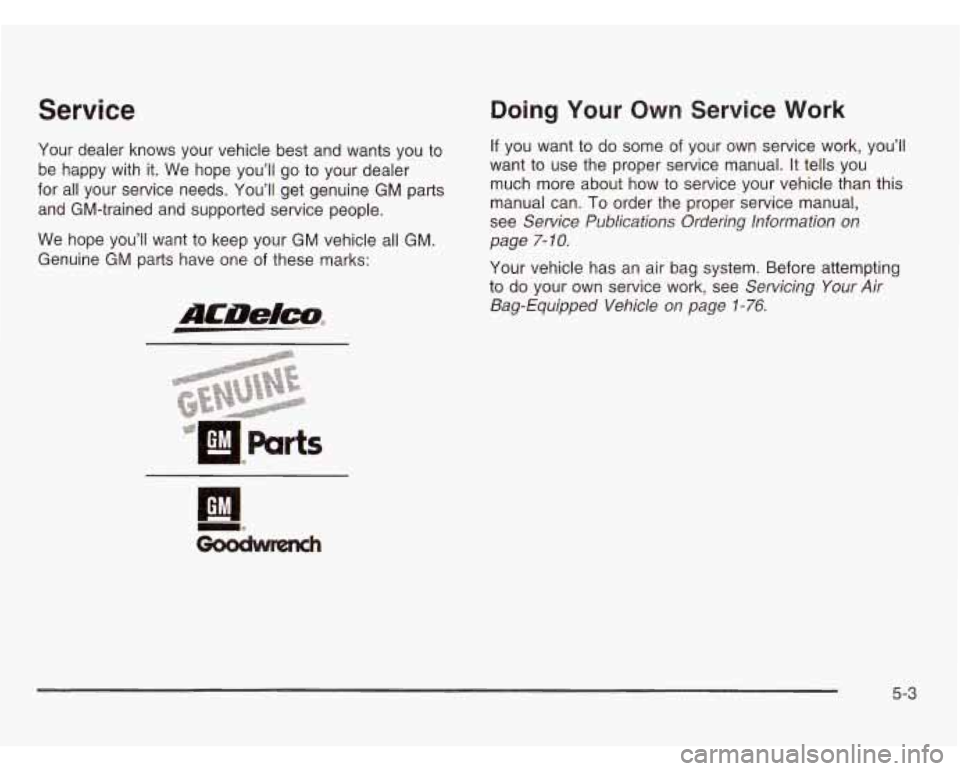
Service
Your dealer knows your vehicle best and wants you to
be happy with
it. We hope you’ll go to your dealer
for all your service needs. You’ll get genuine GM parts
and GM-trained and supported service people.
We hope you’ll want to keep your GM vehicle all GM.
Genuine GM parts have one
of these marks:
Doing Your Own Service Work
If you want to do some of your own service work, you’ll
want to use the proper service manual. It tells you
much more about how to service your vehicle than this
manual can.
To order the proper service manual,
see
Service Publications Ordering Information on
page 7-10.
Your vehicle has an air bag system. Before attempting
to do your own service work, see
Servicing Your Air
Bag-Equipped Vehicle
on page 1-76.
5-3